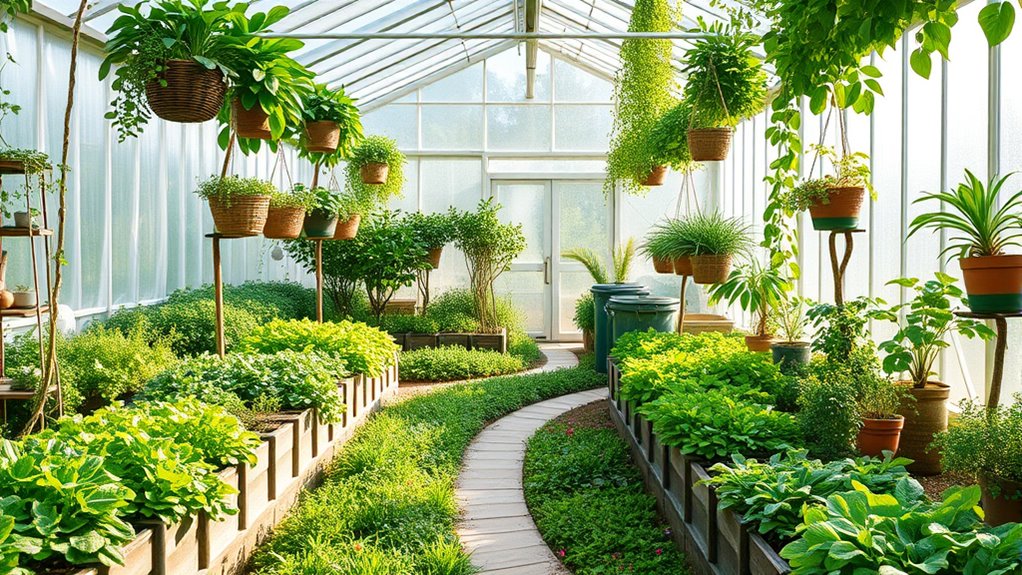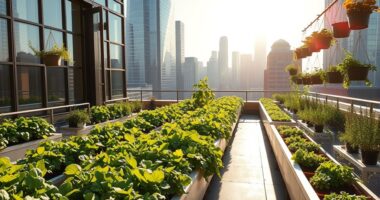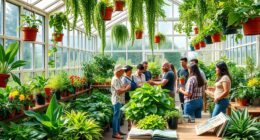Integrating greenhouses with permaculture allows you to create a sustainable, productive system by combining controlled environments with ecological principles. You can maximize year-round food production, conserve resources, and reduce environmental impact. Greenhouses support diverse plants, help minimize pests, and enable climate control, making your system more resilient. Incorporating aquaponics and thoughtful design enhances efficiency and biodiversity. As you explore further, you’ll discover how these systems work together to build a resilient, eco-friendly garden that thrives.
Key Takeaways
- Combining greenhouses with permaculture creates a controlled, sustainable environment that maximizes productivity and resource efficiency year-round.
- Integrating aquaponic systems within greenhouses supports biodiversity, recycles water, and enhances plant and fish health sustainably.
- Climate control in greenhouses stabilizes conditions, reducing external weather impacts and increasing resilience to climate change.
- Permaculture principles in greenhouse design promote ecological balance, soil health, and resource conservation.
- Incorporating sustainable infrastructure like farm cabinets improves organization, functionality, and aesthetic appeal within integrated systems.

Greenhouses and permaculture work hand in hand to create sustainable, productive systems that maximize efficiency and minimize environmental impact. When you combine these approaches, you unlock the potential to grow food year-round while conserving resources. A key aspect of this integration is indoor gardening, which allows you to cultivate plants in controlled environments, making optimal use of space and resources. Inside a greenhouse, you can design your indoor garden to include vegetables, herbs, and even exotic plants that wouldn’t survive outside due to climate limitations. This setup also reduces the need for chemical pesticides, as the controlled environment minimizes pests and diseases.
Indoor gardening in greenhouses maximizes space, reduces pests, and allows year-round cultivation of diverse plants.
Another powerful tool in this integrated system is aquaponic systems, which blend fish farming with plant cultivation. Here, fish waste provides natural fertilizer for your plants, creating a symbiotic relationship that sustains both. You set up aquaponic systems within your greenhouse, making efficient use of vertical space and water resources. Because aquaponics recycles water, it significantly lowers water consumption compared to traditional farming. This method exemplifies permaculture principles by mimicking natural ecosystems, where waste from one element becomes input for another, reducing waste and enhancing productivity.
By incorporating aquaponic systems into your greenhouse, you also enhance biodiversity and resilience. Fish such as tilapia or goldfish thrive in these setups, providing not just fertilizer but also an additional food source. The plants, in turn, purify the water for the fish, creating a balanced, sustainable cycle. This setup is particularly advantageous if you’re limited on land or want to minimize your environmental footprint. It’s a practical way to produce fresh, organic food with less water and energy, aligning perfectly with permaculture’s ethos of working with nature rather than against it.
Indoor gardening and aquaponic systems also give you control over climate conditions, which is vital for growing a diverse range of crops. You can adjust temperature, humidity, and light to maximize growth, reducing the impact of external weather fluctuations. This control makes your system more resilient to climate change and unpredictable weather patterns. Furthermore, integrating these systems encourages you to adopt a permaculture mindset—designing your space to be self-sufficient, resilient, and in harmony with the environment.
An additional benefit is that the selection of vetted farm cabinets can enhance both the functionality and aesthetic appeal of your greenhouse, helping to organize your space efficiently and support your sustainable gardening practices. In essence, combining greenhouses with permaculture principles, especially through indoor gardening and aquaponic systems, creates a sustainable, efficient food production system. It’s an approach that not only maximizes yield but also minimizes resource use and environmental impact. With thoughtful planning, you can develop a resilient, productive garden that sustains you and respects the planet.
Frequently Asked Questions
How Do Greenhouses Affect Local Biodiversity?
Greenhouses can impact local biodiversity by disrupting native species and their habitats. When you introduce non-native plants or materials, you risk competing with or displacing native species, which can harm the ecosystem. Habitat disruption may occur as land is cleared or altered for greenhouse structures. To minimize these effects, you should prioritize native plants and sustainable practices, helping preserve local biodiversity while benefiting from greenhouse cultivation.
Can Permaculture Principles Be Applied in Urban Greenhouse Settings?
You can easily apply permaculture principles in your urban greenhouse, where studies show that urban agriculture boosts local food production by 30%. Focus on composting techniques to enrich your soil naturally, reducing waste and dependency on chemical fertilizers. Incorporate water conservation methods like drip irrigation and rainwater harvesting to optimize resource use. These strategies create a sustainable system, promoting resilience and productivity right in your urban space.
What Are the Initial Costs of Integrating Greenhouses With Permaculture?
You’ll find that the initial costs of integrating greenhouses with permaculture depend on factors like size, materials, and design complexity. Conduct a thorough cost estimation to understand expenses, which can range from affordable DIY setups to more costly professional builds. Consider various funding sources such as grants, community programs, or personal savings to cover costs. Planning ahead helps make certain you can sustainably finance your project and maximize its benefits.
How Do Seasonal Changes Impact Greenhouse-Permaculture Systems?
Seasonal changes substantially impact your greenhouse-permaculture system by affecting seasonal temperature and daylight variation. During colder months, you’ll need to insulate and possibly heat your greenhouse to maintain ideal conditions, while longer daylight hours in summer boost plant growth. Adjust your watering, planting schedules, and crop choices accordingly, ensuring your system remains productive year-round despite the fluctuations in temperature and daylight.
What Are Common Challenges in Maintaining Sustainable Greenhouse-Permaculture Systems?
Maintaining a sustainable greenhouse-permaculture system is like balancing a delicate tightrope. You face challenges like resource management—ensuring water, soil, and energy are used efficiently—and pest control, which requires natural solutions that don’t disrupt the ecosystem. To succeed, you need vigilant monitoring and adaptive strategies, constantly adjusting your practices to keep the system resilient. Staying proactive helps you avoid issues before they escalate, ensuring long-term sustainability.
Conclusion
By embracing both greenhouses and permaculture, you’re not just growing food—you’re nurturing hope for a sustainable future. Together, these systems weave a resilient tapestry of life, demonstrating that your choices today can heal the earth tomorrow. Imagine the power you hold in transforming barren land into a lush, thriving paradise. So, take action now, for in your hands lies the potential to cultivate a world where harmony and abundance flourish forever.








